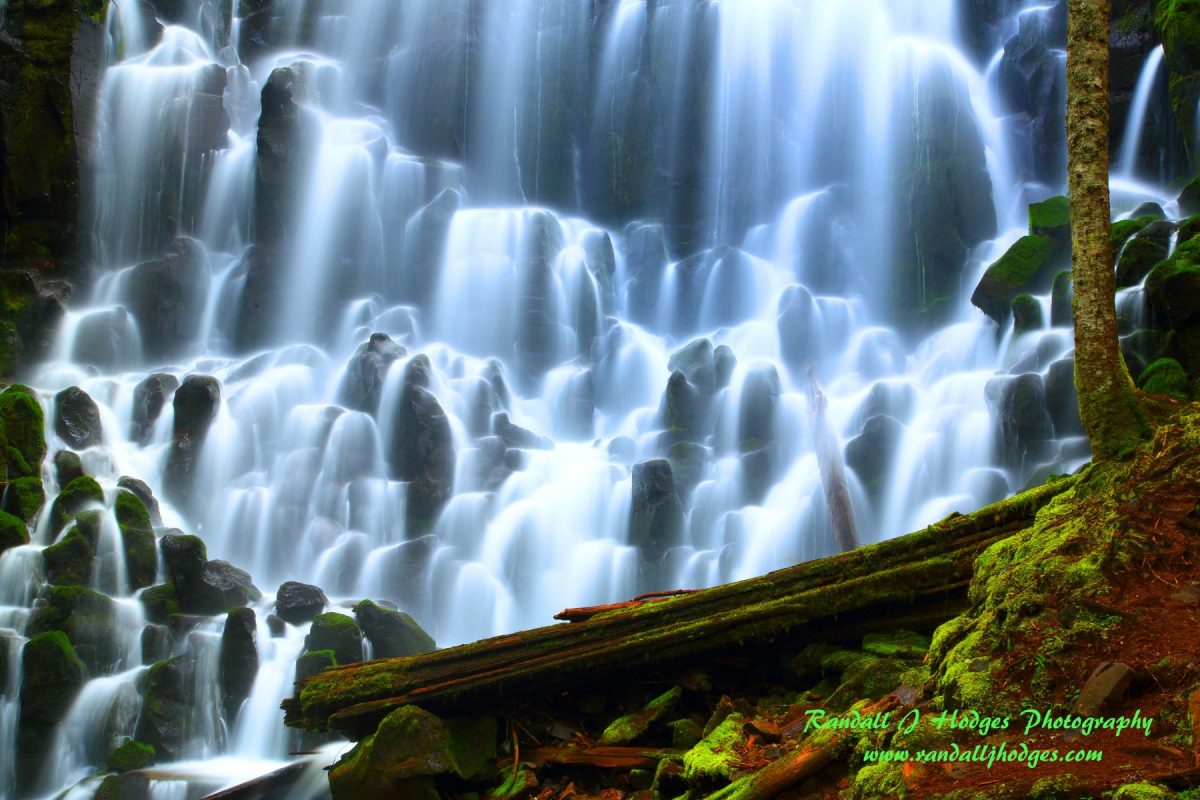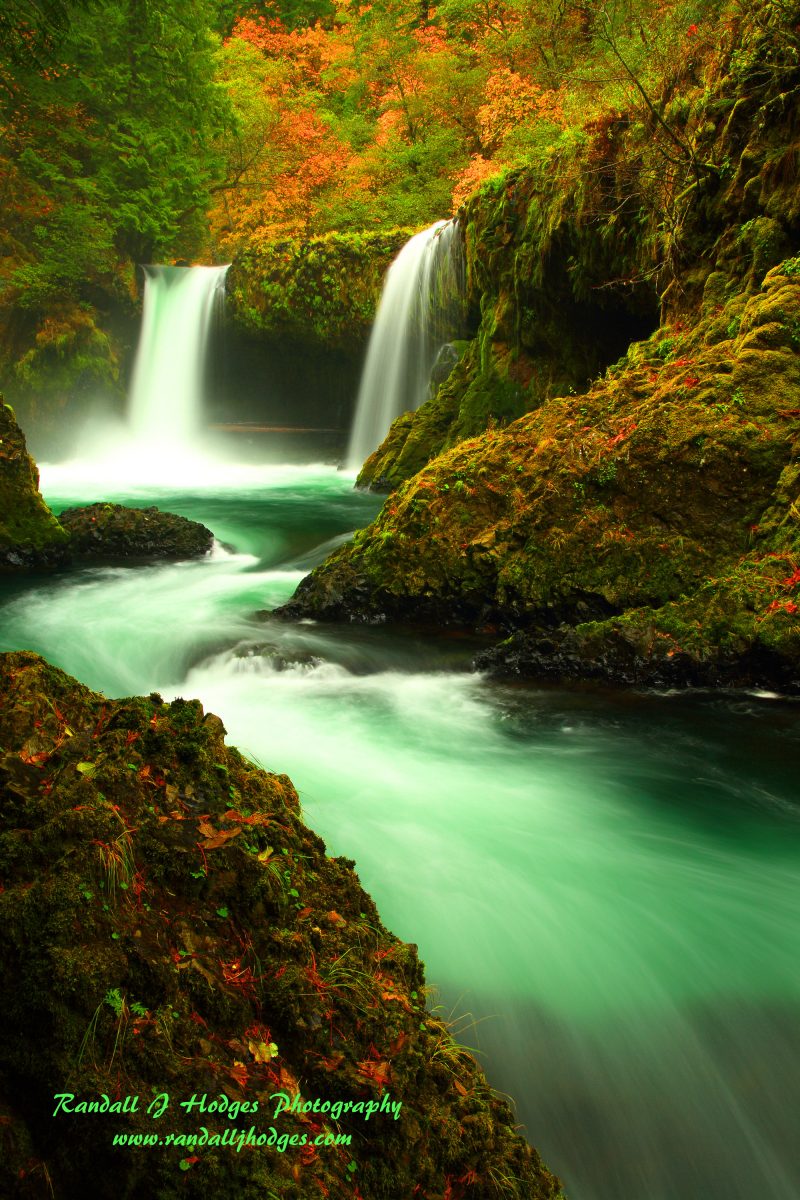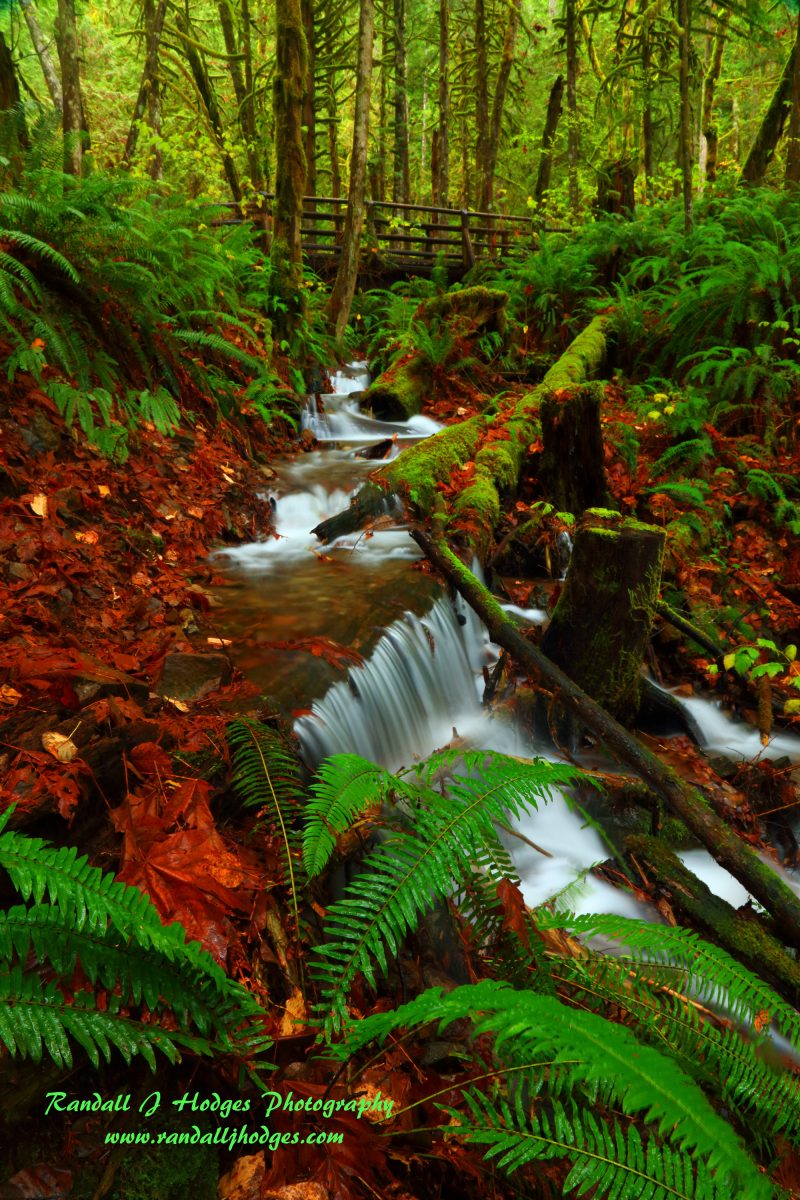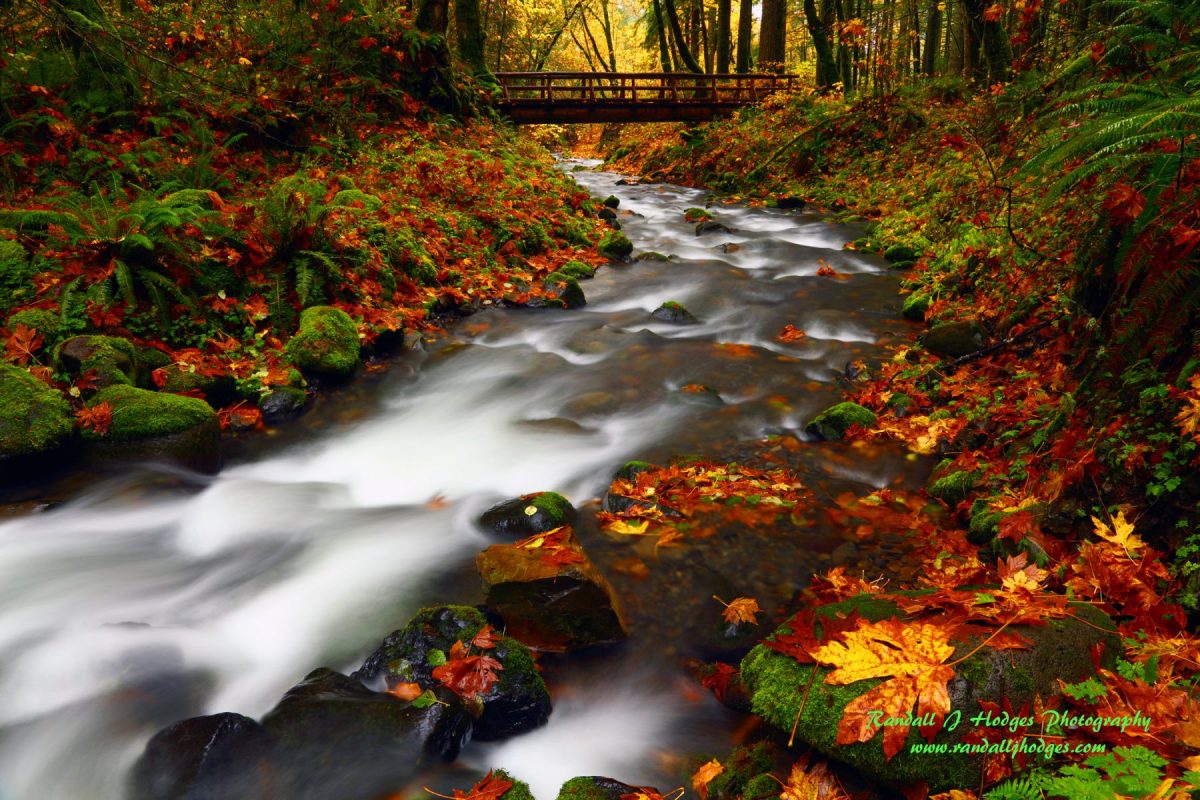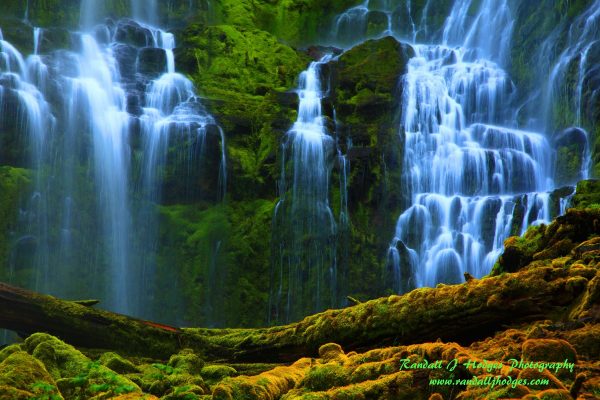
I love shooting creek and waterfalls. I love hiking along creeks and rivers listening to the magical sounds of the flowing waters as they drown out the rest of the world leaving me in the moment along the beautiful forest trails of the Pacific Northwest. I do most of this type of shooting in the spring or fall, and I prefer overcast skies for balanced light, giving me awesome colors and crisp white waters. My second choice would be shade light, and I use this light to my advantage when I want to give the water a blueish tone. This is a technique I developed back in slide film days when I noticed whenever I photographed water in the shade it turned blue. Now I use this technique on my digital cameras while controlling the white balance to produce that film look.
When shooting creeks and waterfalls in the spring, I can count on luxurious green tones as all the leaves in the forest are fresh and new and offer that little extra “Color Pop”. This time of year the creeks and waterfalls are flowing high spring snow melt, so I can count on the correct water volumes that I am looking for. It is always such a treat to walk forest trails this time of year, as all my senses are overcome not only by the beautiful spring greens but also the smells of the forest come alive as the forest wakes up for another summer season.
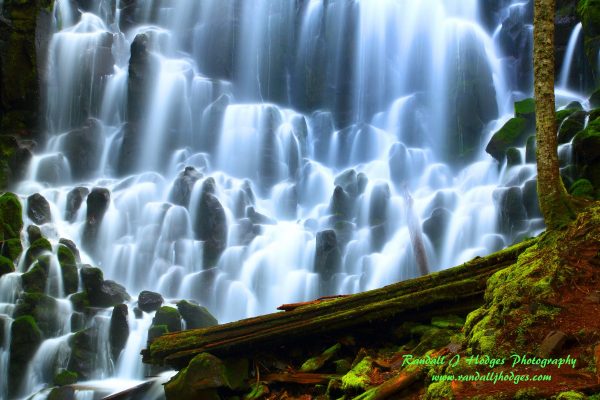
I also love shooting creeks and waterfalls in the fall, when the leaves turn those beautiful yellow, orange and red tones, bringing color into the camera like no other time of year. It is especially spectacular to me when these leaves coat the ground in their brilliant colors. This is when fall shooting is at its best, and again I hope for overcast skies to balance the light, and let me take the long exposures I am hoping for.
As with all of my images, I do all my work in the camera with no post-processing, so the right light is critical to me. Weather I am shooting in overcast skies, rainy weather, or in shade light, I can achieve a balanced light that I find critical for this type of shooting. When shooting creeks and waterfalls, I almost always eliminate sky from the images, keeping my camera down and in that beautiful color I am photographing. This also helps me keep that light balanced.
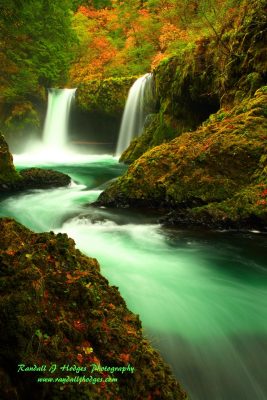
My techniques for this kind of shooting both in spring and fall are very similar. I shoot on either my Canon 5D Mark 3, or on my Canon 5D SR depending on how I feel that day. However, I almost always use the 5DSR for Fall Shooting, as I believe it is a magic camera that time of year. My two favorite lenses are the Canon L Series 16-35 and the Canon L Series 24-105 Mark 2. These two lenses make up about 95% of my creek and waterfall shooting. And of course every one of my lenses has the Singh-Ray Thin Mount LB “Lighter, Brighter” Warming Polarizer on them. Without this polarizer, I would not even bother with this type of shooting, as removing glare and reflection is absolutely mandatory in shooting creeks and waterfalls.
I shoot in aperture priority and I almost always shoot a small aperture light f/18 or f/20 to create maximum depth of field. If you have read my previous blog posts, you will see I also set up the color palette of the camera, which I call “Digital Rolls of Film”. For this type of shooting I am either shooting my “Landscape Roll of film” in the spring, or my “Standard Roll of Film” in the fall. I find fall color can overwhelm the camera a little and the “Standard Roll” is a bit cooler, which is perfect for fall foliage. I love creating a “Roll of Film” for every single situation that I encounter.
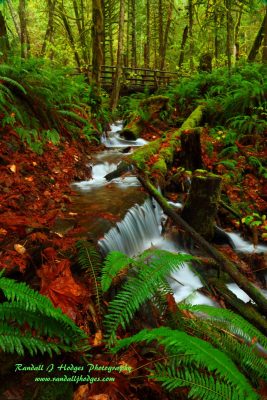
Controlling white balance for All-In-Camera Shooting is critical and can range anywhere between 4,000 to 10,000 K, depending on the light and colors I am shooting. But my starting point is 5600K and I work up or down from there depending on the lighting and the situation. I am always trying to create depth of field, so whenever possible, I try to add foreground to my images. It usually only take a couple of clicks of the shutter to get the white balance and exposure compensation correct, then it is all about nailing that composition.
Another very important factor when doing this type of shooting is shutter speed. Many creek and waterfalls work very well with a very long shutter speeds, so I keep my ISO low at 100 whenever possible. Some of my creek and waterfall images can get all the way up to 30 seconds if the light outside is dark enough. But some creeks and waterfalls need to be finessed, especially if they have a lot of whitewater and/or heavy water-flows. Then, I will raise my ISO until the shutter speed is appropriate for the composition I am shooting. And in some cases I walk away with both a relatively short shutter speed, and a very long shutter speed giving me a very different look to the exact same scene. I find shutter-speed control to be very important in shooting creek and waterfalls, as capturing the right details in the water flow is paramount to the finished image.
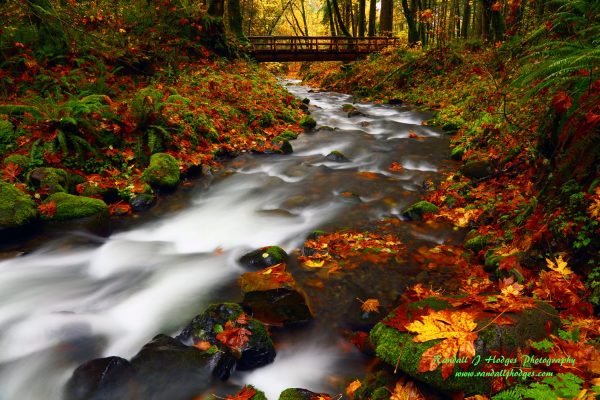
With a little practice and experimenting I am sure you too will be able to capture outstanding images of creeks and waterfalls right in the camera. Just find yourself a fantastic creek or waterfall, set up a composition, and run through all the settings I have just discussed. It will not take long for you to find and create your own vision and style for the subject matter you are trying to capture. And isn’t that what it’s all about? After all, there is no right, wrong way, only one way to do photography. For you, there is just your way, and if it makes you happy, then you are doing it right! Keep that eye in the viewfinder! Happy Shooting Everyone!
Be on the lookout for my upcoming book “Images of the West, A Hiking Photographer’s Adventures in the Western United States and Canada” by your truly, Randall J Hodges. It is a 208-page coffee-table book full beautiful images and insights along with photo tips and techniques.
To learn more about Randall J. Hodges, visit: www.randalljhodges.com
Image shooting data:
01 Fairy Falls, Columbia River Gorge, Oregon. Aperture Priority f/20 @ 4 seconds at 40mm, White Balance 4800K, Landscape Roll of Film, Singh-Ray LB “Lighter-Brighter” Warming Polarizer
01 Fairy Falls, Columbia River Gorge National Scenic Area, Oregon. Aperture Priority f/20 @ 4 seconds at 40mm, ISO 100. White Balance 4800K, Landscape Roll of Film, Singh-Ray LB “Lighter-Brighter” Warming Polarizer, Shade Light
02 Mossy Grotto Falls (AKA Fairyland Falls), Columbia River Gorge National Scenic Area, Oregon. Aperture Priority f/18 @ 2.6 seconds at 24mm, ISO 100, White Balance 6000K, Landscape Roll of Film, Singh-Ray LB “Lighter-Brighter” Warming Polarizer, Overcast Light
03 Fall Color and Latourell Falls, Columbia River Gorge National Scenic Area, Oregon. Aperture Priority f/20 @ 4 seconds at 40mm, ISO 100,White Balance 5800K, Landscape Roll of Film, Singh-Ray LB “Lighter-Brighter” Warming Polarizer, Overcast Light
04 Oneonta Falls, Oneonta Gorge, Columbia River Gorge National Scenic Area, Oregon. Aperture Priority f/18 @ 12 seconds at 40mm, ISO 100, White Balance 9000K, Landscape Roll of Film, Singh-Ray LB “Lighter-Brighter” Warming Polarizer, Shade Light
05 Panther Creek Falls, Columbia River Gorge, Washington, Aperture Priority f/20 @ 1.6 seconds at 24mm, ISO 100, White Balance 5200K, Landscape Roll of Film, Singh-Ray LB “Lighter-Brighter” Warming Polarizer, Overcast Light
06 Proxy Falls, Willamette National Forest, Oregon, Aperture Priority f/6.3 @ .3 seconds at 105mm, ISO 100, White Balance 5000K, Landscape Roll of Film, Singh-Ray LB “Lighter-Brighter” Warming Polarizer, Shade Light
07 Ramona Falls, Mt Hood National Forest, Oregon, Aperture Priority f/20 @ 6.2 seconds at 47mm, ISO 100, White Balance 6000K, Landscape Roll of Film, Singh-Ray LB “Lighter-Brighter” Warming Polarizer, Overcast Light
08 Spirit Falls, Columbia River Gorge, Washington, Aperture Priority f/20 @ 2.0 seconds at 32mm, ISO 100, White Balance 5600K, Standard Roll of Film, Singh-Ray LB “Lighter-Brighter” Warming Polarizer, Overcast Light
09 Seasonal Creek Wallace Falls State Park, Washington, Aperture Priority f/20 @ 4 seconds at 24mm, ISO 400, White Balance 5600K, Landscape Roll of Film, Singh-Ray LB “Lighter-Brighter” Warming Polarizer, Overcast Light
10 Fall Color and Gorton Creek, Columbia River Gorge National Scenic Area, Oregon, Aperture Priority f/20 @ 4 seconds at 24mm, ISO 100, White Balance 5200K, Standard Roll of Film, Singh-Ray LB “Lighter-Brighter” Warming Polarizer, Overcast Light

